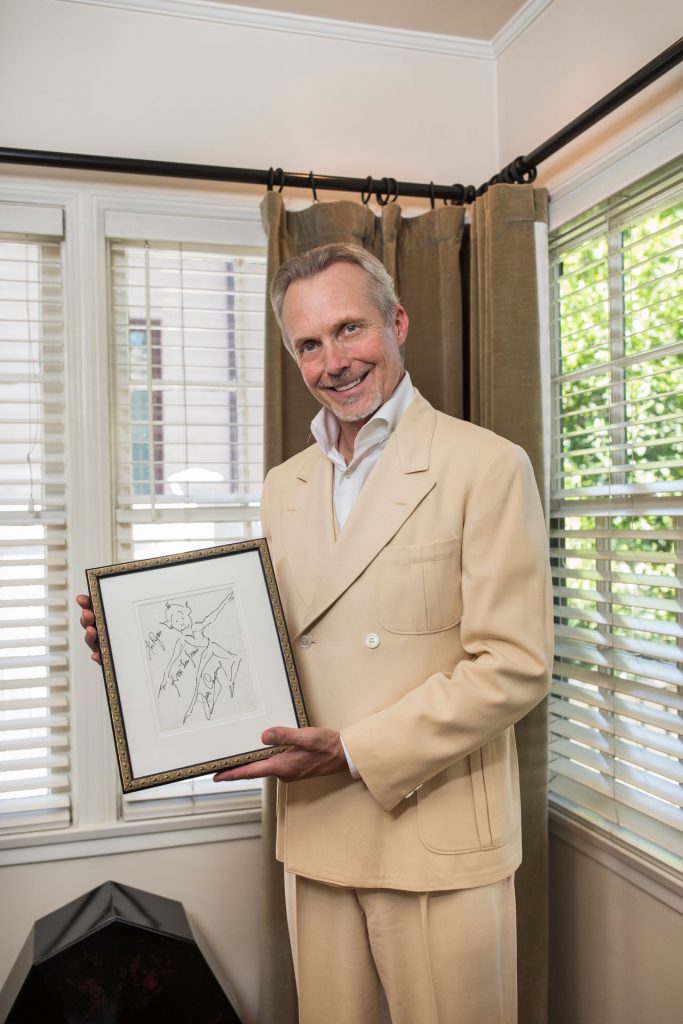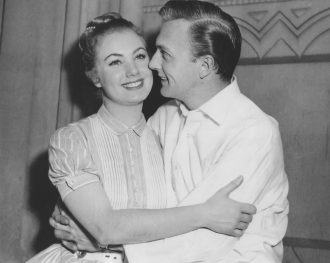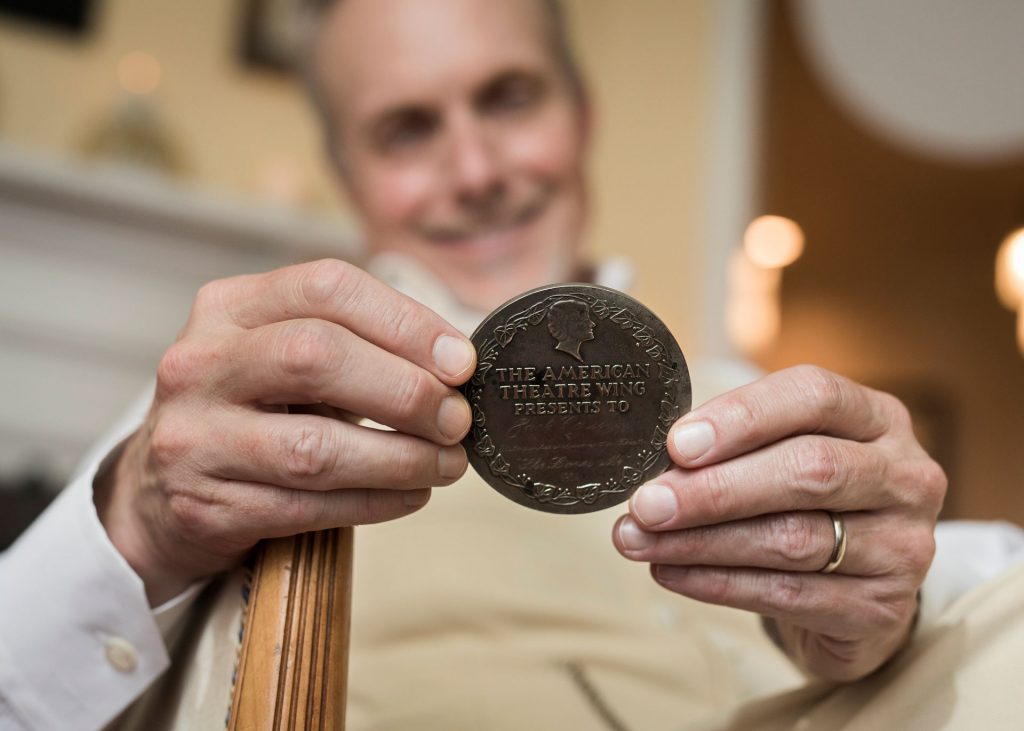
Ryan Cassidy’s Toluca Woods home is filled with history. Some of it came naturally to him, as the son of famed actor–singers Shirley Jones and Jack Cassidy, the half-brother of pop superstar David Cassidy, and brother of actors Shaun and Patrick Cassidy. Mementos of his family’s legacy are displayed throughout the house, including his father’s Tony Award for She Loves Me and a photo of Bob Hope presenting his mother with her Academy Award for Elmer Gantry.
But Cassidy’s collection goes far beyond heirlooms and was strongly shaped by his father’s love for antiques. “When I was growing up, I loved my dad’s passion for history and artifacts and things that tell a story,” he says. “And that stayed with me. I lost my dad at the age of 10, so it was just more embedded in me afterward.”

Since then, he’s collected whatever historical things strike his interest — classic cars, nautical artifacts (including Titanic and Lusitania memorabilia), vintage men’s clothing, toy trains, Revolutionary and Civil War items, antique paintings and more. “I do a lot of reading, and something will trigger me and I’ll want to collect that,” he explains. “Like old houses, objects have a kind of energy to them. It’s about a story, a time and a place that is gone. My feeling is that you’ll never recapture that time again, so the only way to remember it is to either read about it or learn about it through objects. That’s why I like museums and I like collecting. It’s a rescue mission of sorts.”
This mission extends beyond his personal collection; Cassidy also serves as board chair of archives and exhibits for the Los Angeles Police Museum. “I love teaching through objects, showing how things looked, how they were made, how they tell us about a different time,” he says.
He also brings his appreciation for aesthetic beauty, craftsmanship and design to his work as a set dresser for movies and TV shows. “I incorporate my collecting in being a decorator, searching for certain kinds of pillows, fabrics or furniture that I know would be just right,” he says. “It’s not quite a paintbrush to a canvas, but you’re dealing in how to arrange things. That gives me a lot of joy and excitement. I come home after a long day and I’m rearranging my house — I’m not kidding.”

The house itself is a testament to Cassidy’s enthusiasm for history. Like many homes in the neighborhood, it was built during World War II for a Lockheed employee; Cassidy bought it from the original owner in 1992. “My brother Shaun said, ‘You should buy this house — it’s a great area and it’s only going to get better,’” he explains. “I basically just remodeled the surface and redid the plumbing. I try to keep the 1940s look of the house; I didn’t want to drastically change it. It’s not modern, but it’s kind of timeless. It’s small, but I love it. James Cagney once said that a small house is like a blanket you can wrap around yourself, and I think that’s a great analogy.”
In moving to Toluca Woods, Cassidy found himself in a community that seemed tailor-made for his interests. “It’s like this place catered to everything I loved,” he exclaims. “Antique cars at Bob’s Big Boy on Friday nights. Architecture. The history of aviation, Amelia Earhart. All these things that I loved as a kid and still love as an adult. There’s a lot of really interesting pockets of history here.”
But it’s not just the history that makes the neighborhood special to him. “I grew up in Beverly Hills, which was a big city that was filled with nothing but money and things that didn’t seem real to me,” Cassidy says. “And I came here and this seemed so real. It really opened my eyes on the Christmas Eve of my first year in the house when I saw the caroling truck coming down the street — I cried. I just thought, ‘This is the most perfect place to live.’ It has a warmth and a small-town, old-school feeling that I love. I know my neighbors, and everybody on this block watches out for each other.”

The area’s blending of Old Hollywood legend with vibrant modern life mirrors Cassidy’s own experience: “There’s a lot of closeness about the whole environment here because of my mother and my father and my family. I feel very connected to it because of that. And now I get to raise my daughter in it. When she was 3 or 4, we went across Camarillo to go trick-or-treating and ran into Garry Marshall, and Joe Mantegna was dressed up as Dracula. They were the most loving people, handing out candy themselves, and I thought, ‘They’re sharing their neighborhood with everybody.’ And it made me feel so lucky to live here.”
Cassidy acknowledges that his devotion to history may seem eccentric to some. “My brother used to tell me, ‘You live in today. You live in now,’” he says. “And I do live in now. But I also appreciate so much of what the past was. Now’s going to be gone. Now’s going to be yesterday. So for me, it’s about enjoying the moment, but also appreciating, say, a beautiful piece of French sculpture — knowing where it came from and who made it and what it’s made out of, who was alive then and what was happening, the culture and the politics, the whole story.”
Online Extra: Cassidy’s Collecting Tips

“I think that people who want to get into historical collecting should first decide what their budget is, because there are levels at the beginning and at the higher end,” Cassidy advises. “I think you should investigate the availability of it. You should look into condition, which is always the most important thing with collecting — if you buy something that’s pristine, you’re always going to have a better return on your investment, especially in things like cars and old weapons. My suggestion is that whatever you decide to collect, explore it first and learn about what’s out there. Find out where the shows are, where you can go and actually see it. Be careful about anything you buy online. Just educate yourself as much as you can on it — you can really learn a lot on collector website forums. A lot of things can be copied, so you have to educate yourself so you don’t get burned by buying something and then finding out later that it’s a replica. I’ve had that happen to me many, many times; every collector has. You just have to learn, and then hope that you don’t let it happen too many times, because that can be expensive.
“Part of the fun for me in collecting is the hunt,” he adds. “The hunt is the challenge. Once you actually get the object and display it, you look at it and think, ‘That’s great — now where’s the challenge?’ That’s where it becomes almost like a disease. You’re just constantly looking for stuff all the time. My wife says, ‘You’re on eBay again?’ and I say, ‘Yeah, but I didn’t buy anything this week.’ And she’s like, ‘Yeah, right, then why was there a box at the front door this morning?’”

Read “Three Stooges Walk Into a Bar in Toluca Lake…” for Cassidy’s reminiscences about the Money Tree, the bygone local watering hole once owned by members of the Three Stooges.
